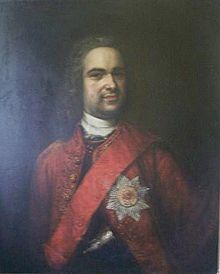Bernhard Leopold Volkmar von Schomburg


Bernhard Leopold Volkmar von Schomburg (* February 20, 1705 ; † 1771 in Itzehoe ) was a royal Danish conference and budget councilor from 1736 to 1746 under Christian IV. President of the city of Altona .
Life
Count Volkmar (also: Volckmar ) von Schomburg was the son of Leopold von Schomburg, who had been in the service of Princely Schwarzburg since the end of the 17th century and whose imperial nobility from Emperor Charles VI. had been renewed. The son Volkmar, initially in the service of Count Stolberg in Wernigerode , went to Glückstadt in 1731 as a royal Danish judicial and government advisor and was born in 1736 when the Danish King Christian VI. Lived in Altona, called to the city as president. During his ten-year term in office, he lived in a palace on Elbstrasse. In 1746 Schomburg gave up the office of president after he had finally taken over the business of the district administrator there as chief inspector of the Wandsbek office. He retired with his wife Esther Elisabeth, geb. von Schubart, returned to his Mehlbeck estate . After selling the property in 1766, he lived in Itzehoe until his death in 1771.
Volkmar von Schomburg was the bearer of the Red Eagle Order . His daughter Maximiliane Dorothea Juliane von Schomburg (* 25 August 1746, † 17 February 1795) was married to the Danish major general Johan Rantzau Kaas (1707–1788).
Act
A contemporary judgment was that one could not set foot in Altona without stepping on Schomburg's work. After his resignation from office in 1746, he himself saw his particular merit in the fact that during his tenure alone the Altona Mediterranean fleet had grown by 30 ships, for which he saw the reason in his own participation in maritime trade with a total of six ships.
Volkmar von Schomburg designed the police system and poor relief in Altona. He strongly promoted the establishment of an academic high school in the city, which, founded in 1738, was baptized Christianeum after the Danish king in 1744 and he became the first high school . In 1740, as Commissarius, he was significantly involved in the settlement of a long-running border dispute between Altona and Hamburg , which he was able to resolve in a settlement, highly respected by both sides. On April 11, 1742, in the presence of many people and high-ranking Altona citizens, including for example Johann Bolten , the first provost of Altona, he laid the foundation stone for a new main church, St. Trinity , which was designed the following year by the then well-known Holstein architect Cay Dose (1700–1768) was built. Schomburg had a larger breeding and work house built with a chapel.
With the death of Christian VI. In 1746, the special favor that Schomburg had received as a member of the Kulmbach party from Queen Sophie Magdalene , a born princess of Brandenburg-Kulmbach, also went out. With the change of government in Copenhagen , Schomburg saw himself exposed to “intrigues” and, after he said he had “made the city of Altona from a nest into a handsome place”, resigned his offices and became a privateer .
literature
- Ernst Heinrich Kneschke (ed.): New general German nobility lexicon [...] in association with several historians . Eighth volume. Leipzig 1808; P. 323
- Gottfried Lintzer: Our old pictures. In: Christianeum. 7th year, Hamburg 1951, issue 2, pp. 7-13.
Individual evidence
- ^ Kneschke : German Adels Lexicon . 1808, p. 323.
- ↑ a b Gottfried Lintzer: Our old pictures. In: Christianeum. 7th year, 1951, issue 2, p. 9.
- ^ HW Harbou: Kaas, Johan Rantzau . In: Carl Frederik Bricka (Ed.): Dansk biografisk Lexikon. Tillige omfattende Norge for Tidsrummet 1537-1814. 1st edition. tape 9 : Jyde – Køtschau . Gyldendalske Boghandels Forlag, Copenhagen 1895, p. 62 (Danish, runeberg.org ).
- ↑ Hamburg State Archives CI II nr 21 b) Volume 5, Part 1 u. 2. Quoted from: Lintzer (1951), p. 7; P. 9.
- ↑ Between your royal. Majesty to Denmark, Norway, etc. etc. and the city of Hamburg established Altonaischer Gränzvergleich, dd 17 Nov 1740. In: Collection of Hamburg laws and constitutions [...] including historical introductions. The tenth part. Hamburg 1771, pp. 169-179. ( books.google.de ).
- ↑ Hamburg State Archives CI II nr 21 b) Volume 5, Part 1 u. 2. Quoted from: Lintzer (1951), p. 8.
| personal data | |
|---|---|
| SURNAME | Schomburg, Bernhard Leopold Volkmar von |
| ALTERNATIVE NAMES | Schomburg, Bernhard Leopold Volkmar Graf von |
| BRIEF DESCRIPTION | Royal Danish civil servant and President of Altona |
| DATE OF BIRTH | February 20, 1705 |
| DATE OF DEATH | 1771 |
| Place of death | Itzehoe |

